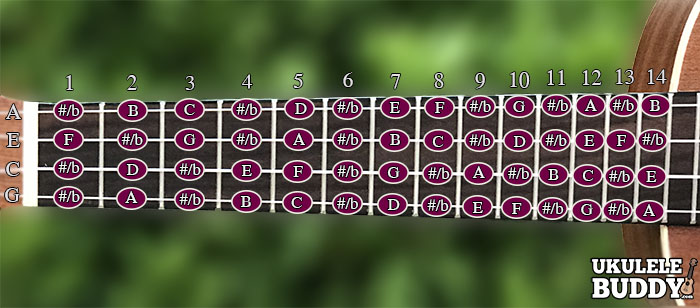Ukulele Notes and Chords
What is a ukulele note?
Pressing any string on any fret produces a note or a pitch. Playing one note on a ukulele is the equivalent of pressing one key on a piano. These notes are combined to construct chords. Later, you will also learn the notes to play scales. Below is a diagram, in which you can see all of the individual notes labeled.

Why do some notes have two names?
In the image above, you can see that several notes are named #/b. This represents a note that has two names. For example, the first fret of the A string is called an A# (A sharp) or Bb (B flat). In reality, these two notes produce the same pitch, but to follow the laws of music it was necessary to name them this way. Depending on the context, you will see these notes written both ways.
How many notes are on a ukulele?
Every ukulele has a specific number of frets. The number of frets multiplied by the 4 strings, plus the 4 open strings, equals the total number of notes on your specific ukulele. For example, a 15 fret ukulele contains 64 notes.
What is a ukulele chord?
A chord is a combination of harmonious pitches, or notes. Usually there are three or more notes in a chord. The word chord is derived from the French word for agreement, or accord. So, a music chord is simply multiple pitches sounding together in harmony. These chords are typically named after the note that you can hear most prominently.
What are ukulele tabs?
If you’re just starting out, you likely don’t know how to read music. That is totally okay because there is a thing called a tablature, or tabs for short. You can imagine it as a chord diagram on its side. The four horizontal lines represent your strings, starting with the G string on the bottom to the A string on top. Tabs are meant to be read from left to right. The number on the string represents which fret you should press, and therefore which string you should pluck. If the numbers are stacked vertically, then those strings are played at the same time. Give it a try using the tablature below.



